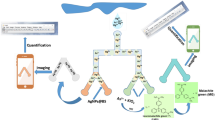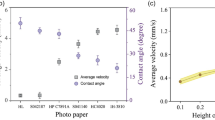Abstract
Monitoring of toxic contaminants is very important for the preservation of the environment. Arsenic contamination of drinking water is a major global problem. Its maximum contamination limit (MCL) in drinking water is 0.01 mg/l as per the World Health Organization (WHO) and 0.05 mg/l in absence of alternate sources as per the Bureau of Indian Standards (BIS) for drinking water. Cancer, diabetes, and cardiovascular problems are also linked to arsenic poisoning. In this work, a detection mechanism based on colorimetry, for detecting trivalent arsenic in water, is presented. Polydimethylsiloxane (PDMS)-based microfluidic channels are fabricated with the help of the x-ray lithography (XRL) technique. An embedded system is integrated to detect the concentration of arsenic within the range of 0.1 to 3.0 mol/l. The microfluidic system consists of a fluid handling setup, colorimetric data acquisition, and a Raspberry-Pi-based smart sensing platform. It was calibrated by placing it in a compact and rugged enclosure to nullify the lighting interference without compromising the accuracy. The detection limit was found out to be 0.07767 µg/l, and the detection time required was about 1 min/sample. This method has the potential to be developed as a rapid field kit.
















Similar content being viewed by others
Data Availability
Authors confirm that all relevant data are included in the article.
Code Availability
Not applicable.
References
Balpande, S. S., & Pande, R. S. (2016). Design and fabrication of non silicon substrate based MEMS energy harvester for arbitrary surface applications. AIP Conference Proceedings, 1724, 020099. https://doi.org/10.1063/1.4945219
Balpande, S. S., Pande, R. S., & PatrikarRajendra, M. (2016). Design and low cost fabrication of green vibration energy harvester. Sensors and Actuators A: Physical, 251, 134–141. https://doi.org/10.1016/j.sna.2016.10.012
Balpande, S. S., Bhaiyya, M. L., & Pande, R. S. (2017). Low-cost fabrication of polymer substrate-based piezoelectric microgenerator with PPE, IDE and ME. Electronics Letters, 53(5), 341–343. https://doi.org/10.1049/el.2016.4099
Balpande, S. S., Kalambe, J. P., & Pande, R. S. (2019). Development of strain energy harvester as an alternative power source for the wearable biomedical diagnostic system. Micro & Nano Letters, 14(7), 777–781. https://doi.org/10.1049/mnl.2018.5250
Balpande, S. S., Pande, R. S., & Patrikar, R. M. (2021). Grains level evaluation and performance enhancement for piezoelectric energy harvester. Ferroelectrics, 572(1), 71–93. https://doi.org/10.1080/00150193.2020.1868874
Balpande, S.S., Pande, R.S. (2015). Design and simulation of MEMS cantilever based energy harvester-power source for pi** health monitoring system. National Conference on Recent Advances in Electronics & Computer Engineering (RAECE), Roorkee, 2015, pp. 183–188. https://doi.org/10.1109/RAECE.2015.7509886
Balpande, S. S., Lande, S. B., Akare, U., Thakre, L. (2009). Modeling of cantilever based power harvester as an innovative power source for RFID tag. 2009 Second International Conference on Emerging Trends in Engineering & Technology, Nagpur, pp. 13–18. https://doi.org/10.1109/ICETET.2009.152
Balpande, S. S., Kalambe, J., Pande, R. S. (2018). Vibration energy harvester driven wearable biomedical diagnostic system. In IEEE 13th Annual International Conference on Nano/Micro Engineered and Molecular Systems (NEMS), Singapore, pp. 448–451. https://doi.org/10.1109/NEMS.2018.8556864
Bhavishya, W., Suresh, B., Jayu, K. (2019). Development of microfluidic paper based analytical device for detection of phosphate in water. International Journal of Innovative Technology and Exploring Engineering (IJITEE), 8(6S), 592–595.
Buchet, J. P., Lauwerys, R., & Roels, H. (1980). Comparison of several methods for the determination of arsenic compounds in water and in urine. International Archives of Occupational and Environmental Health, 46, 11–29.
Cherian, T., & Narayana, B. (2005). A new spectrophotometric method for the determination of arsenic in environmental and biological samples. Analytical Letters, 38, 2207–2216.
Chung, C., et al. (2015). Fabrication of PDMS passive micromixer by lost-wax casting”. International Journal of Precision Engineering and Manufacturing, 16(9), 2033–2039.
Dhamgaye, V. P., Lodha, G. S., Gowri, S. B., & Kant, C. (2014a). Beamline BL-07 at Indus-2: a facility for microfabrication research. Journal of Synchrotron Radiation, 21(1), 259–263. https://doi.org/10.1107/S1600577513024934
Dhamgaye, V. P., Tiwari, M. K., Sawhney, K. J. S., & Lodha, G. S. (2014b). Microfocussing of synchrotron X-rays using X-ray refractive lens developed at Indus-2 deep X-ray lithography beamline. Pramana, 83(1), 119–129. https://www.ias.ac.in/article/fulltext/pram/083/01/0119-0129.
Dhar, R. K., Zheng, Y., Rubenstone, J., & van Geen, A. (2004). A rapid colorimetric method for measuring arsenic concentrations in groundwater”. Analytica Chimica Acta, 526, 203–209.
Dhone, M. D., Gawatre, P. G., & Balpande, S. S. (2018). Frequency band widening technique for cantilever-based vibration energy harvesters through dynamics of fluid motion. Materials Science for Energy Technologies, 1(1), 84–90. https://doi.org/10.1016/j.mset.2018.06.002
Gurushree, D., Vishal, R., Suresh, B. (2019). Detection of mercury in water using filter paper based channel and colorimetric-android readout. International Journal of Engineering and Advanced Technology (IJEAT), 2249–8958. https://doi.org/10.35940/ijeat.B3089.129219
Jattalwar, N., Balpande, S. S., & Shrawankar, J. A. (2020). Assessment of denim and photo paper substrate-based microstrip antennas for wearable biomedical sensing. Wireless Personal Communications. https://doi.org/10.1007/s11277-020-07665-9
Li, S., Zhang, C., Wang, S., Liu, Q., Feng, H., Ma, X., & Guo, J. (2018). Electrochemical microfluidics techniques for heavy metal ion detection. The Analyst. https://doi.org/10.1039/c8an01067f
Lin, Y., Gritsenko, D., Feng, S., Teh, Y. C., Lu, X., & Xu, J. (2016). Detection of heavy metal by paper-based microfluidics. Biosensors and Bioelectronics, 83, 256–266. https://doi.org/10.1016/j.bios.2016.04.061
Muluneh, M., & Issadore, D. (2013). Hybrid soft-lithography/laser machined microchips for the parallel generation of droplets. Lab on a Chip, 13, 4750–4754.
Narakathu, B.B., Avuthu, S.G., Eshkeiti, A., Emamian, S., & Atashbar, M.Z. (2015). Development of a microfluidic sensing platform by integrating PCB technology and inkjet printing process. IEEE Sensors Journal, 15(11), 6374–6380. https://doi.org/10.1109/JSEN.2015.2457239
Online document Radheyshyam Jadhav. (2017). 19% of Indians drink water with lethal levels of arsenic, The Times of India. Retrieved May 2020 from https://timesofindia.indiatimes.com/india/19-of-indians-drink-water-with-lethal-levels-of-arsenic/articleshow/62226542. Accessed 10th May 2020
Pasha, C., Narayana, B. (2008). Determination of arsenic in environmental and biological samples using toluidine blue or safranine O by simple spectrophotometric method. Bulletin of Environmental Contamination and Toxicology
Pranjali, C., Rathee, V., Kalambe, J., Kulkarni, P., Balpande, S. S. (2019). Design and development of triboelectric blue energy harvester. International Journal of Engineering and Advanced Technology (IJEAT), 8(5), 1278–1283. Retrieval Number: E7373068519/19©BEIESP
Qi, N., Li, B., You, H., Zhang, W., Longwen, Fu., Wang, Y., & Chen, L. (2014). Surface-enhanced Raman scattering on a zigzag microfluidic chip: Towards high-sensitivity detection of As(III) ions. Analytical Methods, 6, 4077.
Rahul, S., Dhamgaye, V. P., Jain, V. K., Ram, S. P., Mukherjee, C., Pant, B. D., & Lodha, G. S. (2014). Fabrication of high aspect ratio comb-drive actuator using deep x-ray lithography at Indus-2. Microsystem technologies, 20(7), 1273–1280. https://doi.org/10.1007/s00542-014-2230-8
Rajendiran, S., & Coumar, V. (2015). heavy metal polluted soils in India: Status and counter measures. JNKVV Research Journal., 49, 320–337.
Rewatkar, P., Balpande, S., Kalambe, J. (2018). Design and development of PDMS based channel for fluid analysis. Indian Journal of Science and Technology. https://doi.org/10.17485/ijst/2018/v11i36/96827
Rotake, D., & Darji, A. D. (2018). Heavy metal ion detection in water using MEMS based sensor. Materials Today: Proceedings, 5(1 Part 1), 1530–1536. https://doi.org/10.1016/j.matpr.2017.11.242
Sandhu, S. S. (1976). Colorimetric Method for the determination of arsenic(III) in potable water. The Analyst, 101, 856–859.
Sanger, C. R. (1908). The quantitative determination of arsenic by the Gutzeit method. Journal of the American Chemical Society, 30(6), 1041–1042. https://doi.org/10.1021/ja01948a018
Suroosh, A., Vishal, R., Jayu, K., Suresh, B. (2019). Cadmium contaminated water detection with interdigitated electrodes and microfluidic system. International journal of Engineering and Advanced Technology (IJEAT), 8(5), 1137–1140. Retrieval Number E7372068519/19©BEIESP
Suzuki, K., Asahi, K., Watanabe, A. (2015). Basic study on receiving light signal by LED for bidirectional visible light communications. Electronics and Communications in Japan, 98(2), 1–9. https://doi.org/10.1002/ecj.11608
Verma, N., & Singh, M. (2005). Biosensors for heavy metals. BioMetals, 18(2), 121–129.
Waghwani, B. B., Ali, S. S., Anjankar, S. C., et al. (2020). In vitro detection of water contaminants using microfluidic chip and luminescence sensing platform. Microfluidics and Nanofluidics, 24, 73. https://doi.org/10.1007/s10404-020-02381-z
Whitesides, G. M. (2006). The origins and the future of microfluidics,". Nature, 442(7101), 368–373.
**a, Y., et al. (1996). Complex optical surfaces formed by replica molding against elastomeric masters. Science, 273, 347–349.
Acknowledgements
The fabrication work for the microchannels was carried out within the framework of Indus 2, at x-ray lithography beam line (BL-07) at RRCAT, Indore, India. The authors would like to acknowledge Mr. Nitin Khantwal for his strong technical assistance throughout the fabrication work. The authors would also like to thank Dr. Arvind Kumar Srivastava for his support during the fabrication process of the microchannels. This work was also supported by Center for Microsystems, Young Faculty Research Scheme, Shri Ramdeobaba College of Engineering and Management (RCOEM), Nagpur, India, and DST FIST (Level-0). We also acknowledge Dr. Suraj Butoliya and Dr. Pandhurnekar from Department of Chemistry, RCOEM, for hel** us in sample preparation and testing. We are also thankful to Dr. Mahendra Kadu and Dr. Trupti Gupta in-charge Environmental Engineering lab, Department of Civil Engineering, RCOEM, for providing lab support inclusive of spectrophotometer.
Author information
Authors and Affiliations
Corresponding author
Ethics declarations
Conflict of Interest
The authors declare no competing interests.
Additional information
Publisher's Note
Springer Nature remains neutral with regard to jurisdictional claims in published maps and institutional affiliations.
Rights and permissions
About this article
Cite this article
Ali, S.S., Waghwani, B.B., Anjankar, S. et al. Microfluidic Based Analyzer for Water Dissolved Arsenic (AsIII) Detection. Water Air Soil Pollut 232, 507 (2021). https://doi.org/10.1007/s11270-021-05449-w
Received:
Accepted:
Published:
DOI: https://doi.org/10.1007/s11270-021-05449-w




